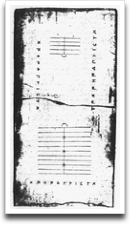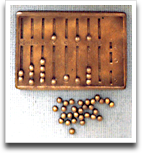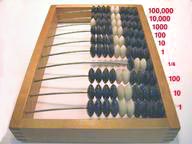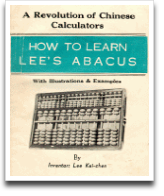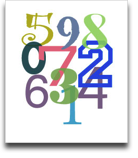Abacus is a Latin word that has its origins in the Greek words abax or abakon (meaning "table" or "tablet") which in turn, possibly originated from the Semitic word abq, meaning "sand". The abacus is one of many types of counting devices which are used to count large numbers.
Why does the abacus exist?
It is difficult to imagine counting without numbers, but there was a time when written numbers did not exist. The earliest counting device was the human hand and its fingers, capable of counting up to 10 things; toes were also used to count in tropical cultures. Then, as even larger quantities (greater than ten fingers and toes could represent) were counted, various natural items like pebbles, sea shells and twigs were used to help keep count.
Merchants who traded goods needed a way to keep count (inventory) of the goods they bought and sold. Various portable counting devices were invented to keep tallies. The abacus is one of many counting devices invented to help count large numbers. When the Hindu-Arabic number system came into use, abaci were adapted to use place-value counting.
Abaci evolved into electro-mechanical calculators, pocket slide-rules, electronic calculators and now abstract representations of calculators or simulations on smartphones.
What is the difference between a counting board and an abacus?
It is important to distinguish the early abacuses (or abaci) known as counting boards from the modern abaci. The counting board is a piece of wood, stone or metal with carved grooves or painted lines between which beads, pebbles or metal discs were moved. The abacus is a device, usually of wood (romans made them out of metal and they are made of plastic in modern times), having a frame that holds rods with freely-sliding beads mounted on them.
Both the abacus and the counting board are mechanical aids used for counting; they are not calculators in the sense we use the word today. The person operating the abacus performs calculations in their head and uses the abacus as a physical aid to keep track of the sums, the carrys, etc.
What did the first counting board look like?
The earliest counting boards are forever lost because they were constructed of perishable materials like wood.
Educated guesses can be made about the construction of counting boards based on early writings of Plutarch and others.
Used in outdoor markets of those times, the simplest counting board involved drawing lines in the sand with ones fingers or with a stylus, and placing pebbles between those lines as place-holders representing numbers (the spaces between the lines would represent the units 10s, 100s, etc.); two pebbles inthe 10s column would indicate 20. Affluent merchants could afford small wooden tables having raised borders that were filled with sand (usually coloured blue or green). A benefit of these counting boards on tables, was that they could be moved without disturbing the calculation— the table could be picked up and carried indoors.
With the need for portable devices, wooden boards with grooves carved into the surface were then created and wooden markers (small discs) were used as place-holders. The wooden boards then gave way to even more more durable materials like marble and metal (bronze) used with stone or metal markers.
COUNTING DEVICES THROUGH THE AGES
The evolution of the counting device can be divided into three ages: Ancient Times, Middle Ages, and Modern Times.
This time-line above (click to enlarge) shows the evolution from the earliest counting board to the present day abacus. The introduction of the Arabic numbering system in Western Europe stopped further development of counting boards. Compare the quick rate of progress in last one-thousand years to the slow progress during the first one-thousand years of civilization.
ANCIENT TIMES
The Salamis Tablet, the Roman Calculi and Hand-abacus are from the period c. 300 B.C.E. to c. 500 C.E.
THE SALAMIS TABLET
The oldest surviving counting board is the Salamis tablet (originally thought to be a gaming board), used by the Babylonians circa 300 B.C., discovered in 1846 on the island of Salamis.
It is a slab of white marble measuring 149cm in length, 75cm in width and 4.5cm thick, on which are 5 groups of markings. In the center of the tablet are a set of 5 horizontal parallel lines divided equally by a perpendicular vertical line, capped with a semi-circle at the intersection of the bottom-most horizontal line and the vertical line.
Below these lines is a wide space with a horizontal crack dividing it. Below this crack is another group of eleven parallel lines, again divided into two sections by a line perpendicular to them but with the semi-circle at the top of the intersection; the third, sixth and ninth of these lines are marked with a cross where they intersect with the vertical line.
Three sets of Greek symbols (numbers from the acrophonic system) are arranged along the left, right and bottom edges of the tablet.
During Greek and Roman times, counting boards, like the Roman hand-abacus, that survive are constructed from stone and metal (as a point of reference, the Roman empire fell circa 500 C.E.).
THE MIDDLE AGES
The Apices, the Coin-board and the Line-board are from the period c. 5 C.E. to c. 1400 C.E.
THE EXCHEQUER
The “exchequer” derives is name from the chequered table which was used in England from c. 1100 for calculating expenditure and receipts.
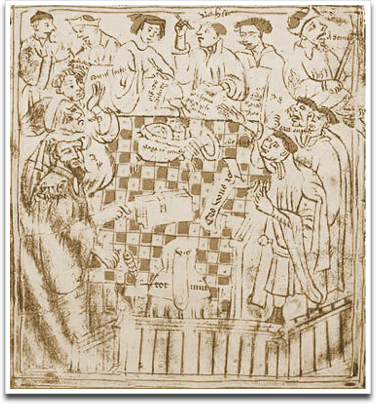
“The Exchequer is an oblong board measuring about 10 feet by 5...with a rim around it about four finger breadths in height, to prevent anything set on it from falling off. Over it is spread a cloth, bought in Easter term, with a special pattern, black, ruled with lines a foot, or a full span, apart. In the spaces between them are placed the counters, in their ranks.
The accountant sits in the middle of his side of the table, so that everybody can see him, and so that his hand can move freely at its work. In the lowest space on the right, he places the heap of the pence; in the second the shillings; in the third the pounds…As he reckons, he must put out the counters and state the numbers simultaneously, lest there should be a mistake in the number. When the sum demanded of the sheriff has been set out in heaps of counters, the payments made into the Treasury or otherwise are similarly set out in heaps underneath. The lower line is simply subtracted from the upper.”
—The Dialogue on the Exchequer, 1177.
In the Middle Ages, wood became the primary material for manufacturing counting boards; the orientation of the beads also switched from vertical to horizontal. In Western Europe, as arithmetic (calculating using written numbers) gained in popularity in the latter part of the Middle Ages, the use of counting boards began to diminish and eventually disappear by 1500.
Arithmetic brought about the invention of logarithms by John Napier and logarithmic scales by Edmund Gunter. In 1622, William Oughtred used these two inventions together and invented the slide rule which lasted until modern times when the scientific calculator became popular in the early 1970s.
MODERN TIMES
The Suan-pan, the Soroban and the Schoty are from the period c. 1200 A.D to the present.
SUAN-PAN
The abacus, called Suan-Pan in Chinese, as it appears today, was first chronicled circa 1200 C.E. in China. The device was made of wood with metal re-inforcements. On each rod, the classic Chinese abacus has 2 beads on the upper deck and 5 on the lower deck; such an abacus is also referred to as a 2/5 abacus. The 2/5 style survived unchanged until circa 1850 at which time the 1/5 (one bead on the top deck and five beads on the bottom deck) abacus appeared.
SOROBAN
Circa 1600 C.E., use and evolution of the Chinese 1/5 abacus was begun by the Japanese via Korea. In Japanese, the abacus is called Soroban. The 1/4 abacus, a style preferred and still manufactured in Japan today, appeared circa 1930. The 1/5 models are rare today and 2/5 models are rare outside of China (excepting Chinese communities in North America and elsewhere).
SCHOTY
The Russian abacus is called a schoty (pronounced "SHAW-tee"). It was invented in the 17th century and is still in use today.
The design of the schoty is based on a pair of human hands (each row has ten beads, corresponding to ten fingers). The abacus is operated by sliding the beads right-to-left.
If you hold out both hands in front of you, palms facing out, you will see that your two thumbs are beside each other and two sets of 4 fingers spread out from there. Similarily, on the schoty, each row has two sets of 4 beads of the same colour on the outside, representing the two sets of 4 fingers and the two inner-most beads of the same colour representing the two thumbs.
The "home" position for the beads is on the right hand side. The bottom-most row represents 1s, the next row up represents 10s, then 100s, and so on. So, counting is similar to counting on one's fingers, the beads move from right to left: 1 to 10, and then carrying upwards to the next row.
Careful observers will note that the metal rods, on which the beads slide, have a slight curvature to prevent the "counted" beads from accidently sliding back to the home-position.
MESOAMERICAN ABACUS
There have been recent suggestions of a Mesoamerican (the Aztec civilization that existed in present day Mexico) abacus called the Nepohualtzitzin, circa 900-1000 C.E., where the counters were made from kernels of maize threaded through strings mounted on a wooden frame. Since it was made from perishable materials it is impossible to know whether such a tool ever existed.
There is also debate about whether the Incan Khipu was a three-dimensional binary calculator or a form of writing, or both.
LEE KAI-CHEN ABACUS
In 1958 Lee Kai-chen published a manual for his "new" abacus designed with 4 decks (it combines two abaci; the top abacus is a small 1/4 soroban and the bottom one is a 2/5 suan-pan). According to the author, multiplication and division are easier using this modified abacus and square roots and cubic roots of numbers can be calculated.
THE ABACUS TODAY
There are stores in China where merchants still use an abacus to tally a customer's bill. The photograph below, was taken by Ed Byrne in 2013, in a store in Hong Kong.

The abacus is still in use today by shopkeepers in Asia and "Chinatowns" in North America. The abacus is still taught in Asian schools, and a few schools in the West. Blind children are taught to use the abacus where their sighted counterparts would be taught to use paper and pencil to perform calculations.
One particular use for the abacus is teaching children simple mathematics and especially multiplication; the abacus is an excellent substitute for rote memorization of multiplication tables, a particularily detestable task for young children. The abacus is also an excellent tool for teaching other base numbering systems since it easily adapts itself to any base.
Portable Computing Devices Today

The abacus, as a portable computing device, continued to evolve into the modern slide-rule, the last mechanical evolution of a portable calculating device before the electronic era brought about digital calculators. In 1972 the Hewlett Packard HP-35 scientific calculator made the slide-rule obsolete.
A few decades later scientific calculators evolved into programmable calculators able to display graphs and images on bitmapped LCD screens.
During the brief period when pocket calculators rose in popularity, the Sorocal/Sorokaru, a hybrid abacus digital calculator was manufactured to help abacus users in the transition.
In the 21st century, portable counting devices rarely exist as separate entities. Instead they are simulated as Apps running on desktop computers, smartphones and tablets. Civilization, which began recording history with a stylus and a clay tablet thousands of years ago is re-using those original terms today.
